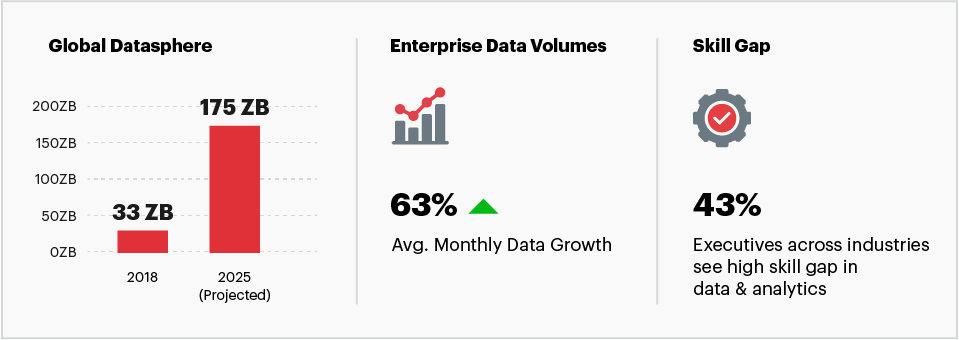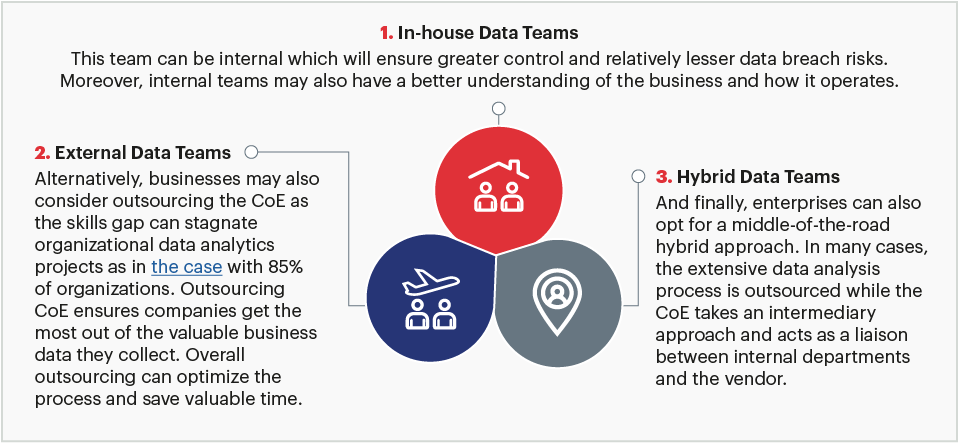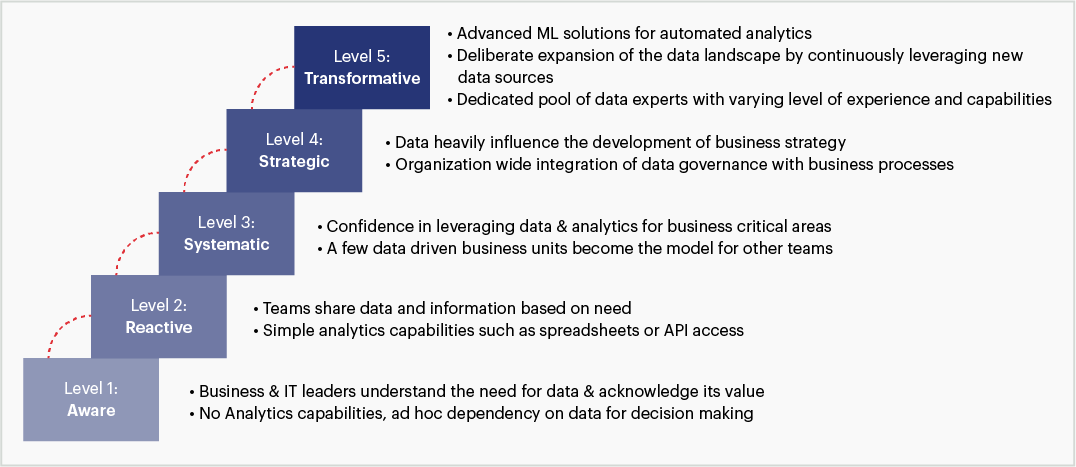How to build a data analytics team to maximize revenue growth for digital business
1. Introduction
Some of the most successful businesses rely on analyzing massive amounts of data for strategic decision making and to make improvements in daily operations. Modern enterprises driven by the data economy, need dedicated data teams today more than ever. In fact, IDC predicts that the volume of global data creation is pegged to reach 175 zettabytes by 2025. Unsurprisingly, the business world is also experiencing a resounding impact of this major surge. Capitalizing on data is dependent on building the right team which must interface between business and IT.
Organizations looking to leverage business data to foster data-driven decision making must carefully sort through the diverse data types and immense volumes to ensure their endeavors are successful. However, studies reveal that executives witness severe data and analytics skill gaps that thwarts their ability to leverage the full potential of data.
In this whitepaper, we shall explore how businesses can build the right type of data teams and establish data analytics strategy discipline to enable insights driven decision making.

Source: Segate, IDC
2. Driving data literacy
The benefits are clear and well defined. But leveraging data analytics is more than just simply running analytics tools. Just like any comprehensive organizational change, it must be driven holistically and integrated with hierarchies under a common mindset. It is paramount that organizations strive to increase holistic data literacy to truly imbibe a data-driven culture, which is a slow and gradual process. Some of the basic tenets of enhancing organizational data literacy include:

Figure: Driving Data Literacy
1. Overcoming the cultural barrier of legacy processes
Data reveals that legacy systems, processes, tools, and skillset that is rife across several companies often act as a barrier to any kind of organizational change. Mostly, the issue is with workforce onboarding as they tend to cling on to “what they know best” and has “worked so far”. However, driving holistic organizational change would entail overcoming these cultural barriers in a quest to embrace the data-driven culture.
2. Fostering interdepartmental cooperation with a single data repository
Actionable corporate data must always be trustworthy and accurate. The same data can be effectively utilized as a reliable base to drive corporate decision-making. However, in many organizations the siloed operational structure often hinders the formation of a SSOT. It is important for organizations to create a single source of information to not only stem costs and data wastage but also to drive data empowered decision making. For this, organizations need to foster data democratization – the creation of an easily accessible database for all corporate sources to contribute.
3. Imbibing technology to generate company-specific data
In the present context, it is an imperative for organizations to account for digital transformation. Technologies like IoT, AI and ML generate streams of data that can be harnessed to drive insight-based business decisions. Organizations should invest the required time and resources to embrace a data-driven path and make substantially more informed decisions.
Other than the basic tenets, the concepts of change management also apply to instituting a data-driven culture. The most important aspect is to ensure holistic transformation across all corners. Organizations set on a data driven path, therefore, must undertake development across business functions in the form of training and resource allocation and the adoption of digital tools to build relevant skillsets.
3. Exploring different models for analytics teams
For large enterprises, it becomes important to build a core group focused on data and analytics. Organizational data ambitions must also be supported with a Data Analytics Center of Excellence (CoE) where a team of experts communicate and collaborate with internal teams to pursue organizational data ambitions.

Figure: Different models for analytics teams
Building in-house data labs can help organizations bolster their data awareness and achieve data goals. However, the lack of adequate and skillful resources can serve as a major impediment towards this vision.
Depending on the specific needs of the organization, you as data and analytics leader can use one or a combination of these governance styles to meet the demands of existing use cases as well as the emerging requirements of digital business. This multistyle, or adaptive, governance approach is ideal for data and analytics, because of both the wide variety of business use cases encountered and the dynamic technology and innovation landscape.

Source: Data & analytics team structures in the enterprise (adapted from Garnter)
Empower marketing teams with high-quality insights.
4. Setting up the team
To build a team of data experts, often the first step includes the assessment of the current organizational data maturity.
Organizational data and analytics maturity assessment
This is a measurement of the extent to which an organization can make use of available data. The higher the maturity index, the better the data utilization is. To assess this, the first step is to clearly outline the desired end state in terms of data maturity and expertise and compare it to the current state. The roadmap for progress must include bridging this gap with tangible key performance indicators (KPIs) wherein important progress-based metrics are regularly measured and used as specific benchmarks for progress tracking. Often bridging the gaps requires hiring and extensive upskilling or reskilling based on current and the desired state.

Figure: Organizational data maturity index
Skill sets needed
The next step would be to build specific expertise for an effective data and analytics team. Some of the key expertise required will include:
Data engineer
They work closely with both data analyst and data scientists to design, build, and maintain datasets that are leveraged across data projects. Their overarching responsibilities include preparing the ecosystem and infrastructure that the organization and its data team rely on. This includes selecting and integrating tools and frameworks. Apart from this, they may also be required to optimize and maintain data warehouses, build data platforms that other D&A team members can use, and collect and integrate data from disparate sources.
Data architect
A data architect designs, manages, deploys, and creates the organizational data architecture. Highly experienced data architects often lead technical teams and help manage data pipelines with high volumes. Although, in the case of smaller teams, the data engineer usually undertakes a portion of these responsibilities.
Data analyst
They work with cleaned and transformed user-friendly data formats to conduct reporting and direct analysis. They are responsible for using data to forecast and suggest business activities, maintain dashboards, prepare data visualizations, and generate reports using descriptive, prescriptive, predictive, or diagnostic analysis.
Business/ BI analyst
They work alongside data scientists to prioritize problems and steer the projects into critical directions. They often act as a conduit between data objectives and related business outcomes. BI analysts are responsible for the conception, control, monitoring, and development of company-wide business intelligence systems.
Data scientist
They typically perform work related to informing and shaping of data projects leveraging advanced tools, programming and technologies such as artificial intelligence, machine learning, and statistical modeling to perform analysis on a large scale. This may involve the identification of challenges that can be addressed with data sources or a specific data project.They help analyze and interpret data and generate reports. They are adept at applying advanced analytical models to solve real world business problems, tune and improve current ML pipeline, test and suggest new data science approaches, and also help the engineering team in testing and scaling.
Team lead
Will lead the overall team. Must be proficient developing Big Data architectures for Hadoop/Spark platform, and have big data development experience on Hadoop platform including Hive, Impala, Sqoop, Flume, Spark. Moreover, experience with data modelling, complex data structures, data processing, data quality and data lifecycle is also highly desired.
Project manager
Primary expertise must include rich experience in managing end to end data projects. Also critical is the understanding and drive to incorporate customer requirements, translate them to objective tasks and manage the overall team towards success.
5. Essential technology enablers
Developing manpower is only a part of the overall target. The team must be supported with complementary technical assets that will help them store, manage, analyze, and leverage data. Technical assets would include:
Data lake & data warehouse
Data lakes enable storage of large volumes of unstructured and unprocessed data. Data warehouses on the other hand host prepared and structured data with a specific purpose. Some of the platforms that can provide a stable basis for organizational data management initiatives include Hadoop, Amazon Redshift, and Google BigQuery.
Analytics tools
Data analysts need several tools to run analytical algorithms and gather insights from the stored business data. Data analytics tools like Alteryx, Anaconda, Grafana, Redash, or cloud provider supplied statistical, and ML task-based tools achieve this purpose.
BI tools
Business Intelligence tools are critical in translating data insights into business insights enabling enterprises make tactical and strategic business decisions. Reports and dashboards can be quickly prepared with BI tools like Qlik, Google’s Data Studio, Matomo, Plausible or MS Power BI.
Data pipeline tools
A data pipeline allows for greater control over data for further processing. Tools like Boomi, Hevo Data, Apache Camel or Talend can leverage an ELT or ETL process to clean and integrate data.
Development environments
Data science programming languages like SQL, Python or R support development environments like Spyder, JupyterLab, or R Studio to enable simple and efficient data processing.
And finally, organizations would do well to embrace agile methodology for optimum data utilization. Agile helps data and analytics teams plan, prioritize, and unlock business value effectively with its dynamic and reactive approach. Moreover, it also accounts for customer, stakeholder, and end-user feedback while helping data teams come up with effective responses.
Conclusion
“One-size fits all” approach will not be feasible for organizations, when it comes to driving data and analytics projects. It is imperative that businesses customize the D&A team structure as per specific conditions and requirements – current structure, context, desired outcomes, and more. Even building D&A teams can be dependent on organizational structure. While dedicated cross-functional teams involving disparate expertise can bring a holistic approach towards a common goal, some organizations may choose to opt for individual, parallel specific D&A teams within each business unit to achieve more granular targets.
Lately, many global enterprises are outsourcing the majority of Data & Analytics expertise. Doing this will not only save companies the time to focus on more mission critical objectives but also enable them to harness the best available data talents and benefit from cross industry best practices.

